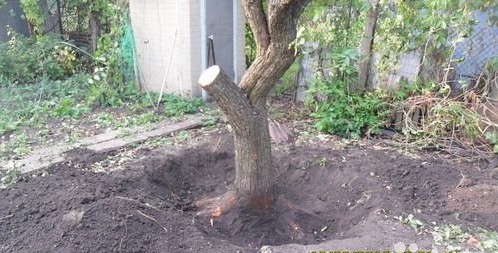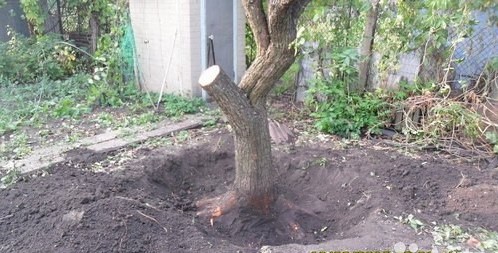There has long been one rule in gardening: after uprooting an old (sick or healthy, dead from frost) tree, you cannot immediately plant a new tree in its place. The soil needs rest.
Over previous years, harmful substances released by roots, leaves, and fungal diseases have accumulated in the soil. The gardener had to fight diseases, often spraying the tree with chemicals, which necessarily got into the soil and accumulated in it. For example, we protect trees from fungal diseases with copper-containing preparations (Bordeaux mixture, Khom, Abiga-Pik). Accumulations of copper in the ground have a depressing effect on some species of newly planted trees, and they will develop poorly.
In addition, each type of tree takes certain nutrients from the soil, and the physical condition of the soil also deteriorates.
Some gardeners try to solve this problem by planting a tree of a different species in the vacant space: instead of an apricot, an apple tree, for example. But under these conditions, the apple tree will lack the nutritional element that the apricot “liked.” And this will negatively affect its development.
Soil fatigue leads to a decrease in the yield of newly planted crops in the place of uprooted trees. It is very difficult to deal with these consequences.
Even annual (vegetable or ornamental) crops suffer from soil fatigue. They should also be planted after 4-5 years at the site of uprooting. Soil fatigue can be relieved by allowing it to rest under black fallow.
Green manure crops heal the soil and relieve soil fatigue: peas, beans, rye, mustard, and rape. They are sown in the summer after harvesting early vegetables. Closer to autumn, when the green manure grows to 15-20 cm, it is embedded in the soil to a depth of 7-15 cm (depending on the type of soil). To improve your health, you can water the soil in the spring with the drug Fitosporin-M. It kills spores of scab, powdery mildew, moniliosis and other fungal diseases.
If it is absolutely necessary for the gardener to occupy the vacant space with a new seedling immediately after uprooting, he will have to dig a larger planting hole - 70x80x100 cm. Fill it with fresh soil. If possible, take soil from a forest belt or from a garden where fruit trees did not grow, mix it with organic and mineral fertilizers (superphosphate, potassium sulfate or wood ash). It is better to apply a complex fertilizer (autumn fertilizer or other autumn fertilizer) as a mineral fertilizer.
What is the point of preparing the planting hole in this way? The roots of a young seedling begin to develop fresh, not contaminated with toxins soil. In it, the seedling takes root early and develops. The roots come out of the planting hole already strong. By this time, soil fatigue will significantly decrease.
A planted tree requires especially careful care: regular watering, annual application of organic fertilizers and biostimulants (extrasol, etc.), sowing green manure crops around the tree. This will contribute to its better development.
Nettle infusion (1:10) is good for healing the soil. It helps to increase the number of earthworms and protects the area from invasion of slugs and fungal diseases. Stale, moldy bread soaked in water (1:2-3) can be scattered over the wet soil of the tree trunk circle and covered with a hoe.
You can add the biological product EM Compost (Baikal) to overworked soil. It activates the activity of microorganisms and improves soil structure.
In autumn, clay soil must be dug up to improve the water-air regime, loosen the top layer, compacted by frequent watering, and improve the flow of oxygen to the roots.If the soil is light and sandy, you can replace digging with processing with a Fokin flat cutter, but watch the consequences of such processing. It can compact the soil and impair water absorption, which negatively affects the growth and development of the plant. But for loosening the surface of the earth after watering (especially if a crust forms), the Fokina flat cutter can be used on any soil.
To restore and maintain soil fertility in the garden, use pitchforks and a flat cutter judiciously, do not overuse watering, and if watering is needed, do it deep, not shallow, loosen it in a timely manner after watering, and the earth will thank you with a harvest.



 CUCUMBERS NEVER GET SICK, I'VE BEEN USING ONLY THIS FOR 40 YEARS! I SHARE A SECRET WITH YOU, CUCUMBERS ARE LIKE THE PICTURE!
CUCUMBERS NEVER GET SICK, I'VE BEEN USING ONLY THIS FOR 40 YEARS! I SHARE A SECRET WITH YOU, CUCUMBERS ARE LIKE THE PICTURE! You can dig a bucket of potatoes from each bush. Do you think these are fairy tales? Watch the video
You can dig a bucket of potatoes from each bush. Do you think these are fairy tales? Watch the video
 How our fellow gardeners work in Korea. There is a lot to learn and just fun to watch.
How our fellow gardeners work in Korea. There is a lot to learn and just fun to watch. Eye trainer. The author claims that with daily viewing, vision is restored. They don't charge money for views.
Eye trainer. The author claims that with daily viewing, vision is restored. They don't charge money for views. A 3-ingredient cake recipe in 30 minutes is better than Napoleon. Simple and very tasty.
A 3-ingredient cake recipe in 30 minutes is better than Napoleon. Simple and very tasty. Therapeutic exercises for cervical osteochondrosis. A complete set of exercises.
Therapeutic exercises for cervical osteochondrosis. A complete set of exercises. Which indoor plants match your zodiac sign?
Which indoor plants match your zodiac sign? What about them? Excursion to German dachas.
What about them? Excursion to German dachas.